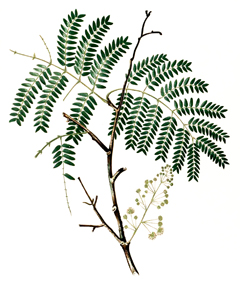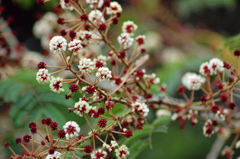 |
|
http://www.edibleplants.org/ |
 |
| Jayesh Patil flickr.com |
Translate this page:
Summary
Acacia concinna is a thorny spreading shrub or tree that can either be scandent or climb into other plants. Bark is light grey. Leaves are oblong 4-10mm long forming 7-11 pairs of branches each with 17-37 pairs of leaflets. Flower buds are purple or dark red. The flowers are cream or white. Pods up to 5cm long are flat and thick with 7 seeds. The seedpods are widely used as a soap substitute in India. Plants flower throughout the year. Fruit are on trees from February to March.The tree is food for the larvae of the butterfly Pantoporia hordonia.
Physical Characteristics

 Acacia_concinna is an evergreen Tree growing to 10 m (32ft) by 10 m (32ft) at a medium rate.
Acacia_concinna is an evergreen Tree growing to 10 m (32ft) by 10 m (32ft) at a medium rate.
See above for USDA hardiness. It is hardy to UK zone 10 and is frost tender. The flowers are pollinated by Bees, beetles, butterflies, wasps.
It can fix Nitrogen.
It is noted for attracting wildlife.
Suitable for: light (sandy) and medium (loamy) soils, prefers well-drained soil and can grow in nutritionally poor soil. Suitable pH: neutral soils. It cannot grow in the shade. It prefers dry soil and can tolerate drought. The plant is not wind tolerant.
UK Hardiness Map
US Hardiness Map
Synonyms
Acacia hooperiana Zipp. ex Miq. Acacia philippinarurn Benth. Acacia poilanei Gagnep. Acacia polyceph
Plant Habitats
Edible Uses
Edible portion: Seeds, Leaves, Flowers, Vegetable. Leaves ? cooked [301]. The acid-flavoured young leaves can be used as a substitute for tamarinds (Tamarindus indica) in chutneys [301]. They are also added to soups to make them hot and sour [301]. They can be curried with salted fish and coconut milk. Flowers - cooked and eaten as a vegetable [301]. Acid fruit are used in Philippine cooking to give a sour flavour. They are roasted and eaten. Seeds are edible after roasting. The young shoots are used to make pickles or cooked as a vegetable.
References More on Edible Uses
Medicinal Uses
Plants For A Future can not take any responsibility for any adverse effects from the use of plants. Always seek advice from a professional before using a plant medicinally.
This plant is used medicinally[266]. There is lots of anecdotal information on its use including: the treating of dandruff and as a natural remedy for lice in both for humans and animals. The treatment of parasite-caused diseases such as malaria and visceral leishmaniasis. As a treatment for mouth and throat problems such as pharyngitis and mouth sores by chewing the pods. Tooth decay and plaque reduction from chewing the sticks. Alleviation of constipation indigestion, and other digestive problems from the fruit pods or a tea made from the leaves. A natural toxic cleanser, laxative, and diuretic. Recent research has shown that the tree has an ?antidermatophytic? ability that can fight off fungi responsible for skin diseases. It also has antimicrobial and antibacterial properties and even contains some phytochemicals that may have antioxidant abilities.
References More on Medicinal Uses
The Bookshop: Edible Plant Books
Our Latest books on Perennial Plants For Food Forests and Permaculture Gardens in paperback or digital formats.

Edible Tropical Plants
Food Forest Plants for Hotter Conditions: 250+ Plants For Tropical Food Forests & Permaculture Gardens.
More

Edible Temperate Plants
Plants for Your Food Forest: 500 Plants for Temperate Food Forests & Permaculture Gardens.
More

More Books
PFAF have eight books available in paperback and digital formats. Browse the shop for more information.
Shop Now
Other Uses
The bark is a source of tannins [439]. This plant is important for its tannins [266]. The pods are rich in saponins [439]. They are widely used in India as a detergent for washing silks and woollen goods, and are also very commonly used for washing the hair [46,439]. They are very effective in cleaning tarnished silver plates[46,439]. It is said that yarn washed with these pods prior to being dyed will produce much better results from the dyeing [439]. In order to prepare it the fruit pods, leaves and bark of the plant are dried, ground into a powder, then made into a paste.
Special Uses
References More on Other Uses
Cultivation details
This species has a symbiotic relationship with certain soil bacteria, these bacteria form nodules on the roots and fix atmospheric nitrogen. Some of this nitrogen is utilized by the growing plant but some can also be used by other plants growing nearby[200].
References Carbon Farming Information and Carbon Sequestration Information
Temperature Converter
Type a value in the Celsius field to convert the value to Fahrenheit:
Fahrenheit:
The PFAF Bookshop
Plants For A Future have a number of books available in paperback and digital form. Book titles include Edible Plants, Edible Perennials, Edible Trees,Edible Shrubs, Woodland Gardening, and Temperate Food Forest Plants. Our new book is Food Forest Plants For Hotter Conditions (Tropical and Sub-Tropical).
Shop Now
Plant Propagation
Acacia concinna can be grown from seeds. The seedlings can be transplanted. The seed of most, if not all, members of this genus has a hard seedcoat and may benefit from scarification before sowing to speed up germination. This can usually be done by pouring a small amount of nearly boiling water on the seeds (being careful not to cook them!) and then soaking them for 12 - 24 hours in warm water. By this time they should have imbibed moisture and swollen - if they have not, then carefully make a nick in the seedcoat (being careful not to damage the embryo) and soak for a further 12 hours before sowing.
Other Names
If available other names are mentioned here
It is also known as: Aila, Atouqie, Banritha, Chikaka, Chikakai, Kochi, Lahiur, Ritha, Shikai, Shikakai, Shikaya, Sige, Sikakai, Soap-pod tree, Som poi, Song bai.
Native Range
TEMPERATE ASIA: Guangdong Sheng, Guangxi Zhuangzu Zizhiqu, Guizhou Sheng, Hunan Sheng, Jiangxi Sheng, Yunnan Sheng, China. TROPICAL ASIA: Bangladesh, Bhutan, India, Nepal, Papua New Guinea, Cambodia, Laos, Myanmar, Thailand, Vietnam, Indonesia, Malaysia (Malaya), Philippines, Singapore,
Weed Potential
Right plant wrong place. We are currently updating this section.
Please note that a plant may be invasive in one area but may not in your area so it's worth checking.
Conservation Status
IUCN Red List of Threatened Plants Status : This taxon has not yet been assessed.

Growth: S = slow M = medium F = fast. Soil: L = light (sandy) M = medium H = heavy (clay). pH: A = acid N = neutral B = basic (alkaline). Shade: F = full shade S = semi-shade N = no shade. Moisture: D = dry M = Moist We = wet Wa = water.
Now available:
Food Forest Plants for Mediterranean Conditions
350+ Perennial Plants For Mediterranean and Drier Food Forests and Permaculture Gardens.
[Paperback and eBook]
This is the third in Plants For A Future's series of plant guides for food forests tailored to
specific climate zones. Following volumes on temperate and tropical ecosystems, this book focuses
on species suited to Mediterranean conditions—regions with hot, dry summers and cool, wet winters,
often facing the added challenge of climate change.
Read More
Expert comment
Author
(Willd.) DC.
Botanical References
0
Links / References
For a list of references used on this page please go here
Readers comment
| Add a comment |
|
If you have important information about this plant that may help other users please add a comment or link below. Only comments or links that are felt to be directly relevant to a plant will be included. If you think a comment/link or information contained on this page is inaccurate or misleading we would welcome your feedback at [email protected]. If you have questions about a plant please use the Forum on this website as we do not have the resources to answer questions ourselves.
* Please note: the comments by website users are not necessarily those held by PFAF and may give misleading or inaccurate information.
To leave a comment please Register or login here All comments need to be approved so will not appear immediately.
|
Subject : Acacia_concinna
|
|
|
|